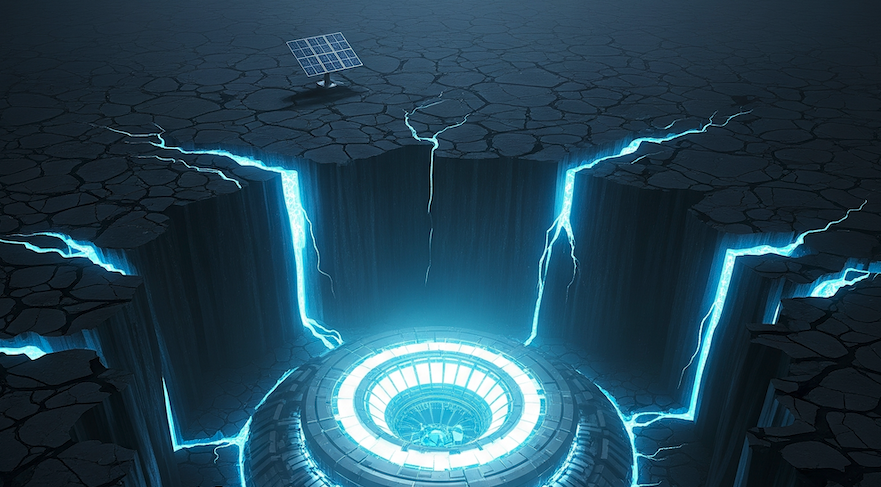What follows is not a sober policy proposal. It is a thought experiment, a flight of fancy designed to shatter the narrow confines of the current energy debate. The public discourse pits solar against fossil fuels as if it were a schoolyard argument, while the real game of power operates on a level of complexity that is rarely, if ever, discussed. This article is a wild, speculative attempt to outline a more complete, if fantastical, doctrine for energy strategy across three domains: strategic deception, tactical resilience, and celestial dominance. None of this is to be taken too seriously.
The Terrestrial Battlefield: The Art of Strategic Deception
The first principle of this doctrine is that a nation’s true energy capacity should be its most closely guarded secret. The ancient military strategist Sun Tzu taught that all warfare is based on deception. Publicly available data on energy production is, in this light, a strategic blunder—it’s like handing your enemy the schematics to your fortress. A wiser, if more paranoid, approach would be to reveal only what a sophisticated AI predicts is the bare minimum necessary to project stability, while concealing the true depth of your power. The real strength lies in the undisclosed—the unexpected and the unseen.
The Deception Layer: Power Beneath the Surface
The ultimate expression of strategic energy deception lies in moving critical infrastructure where it cannot be seen or targeted: underground. To be truly secure, a nation must possess power generation that is impervious to satellite surveillance, drone attacks, and bunker-busting bombs. The most practical technologies for this are nuclear and geothermal. All forms of nuclear reactors, from today’s fission plants to tomorrow’s fusion concepts, can be housed in deep, hardened subterranean bunkers. Geothermal energy, which taps the planet’s own internal heat, is perhaps even more elegant. With a minimal surface footprint, these plants provide constant, 24/7 power, regardless of weather, time of day, or what’s happening on the surface. By creating a distributed network of hidden geothermal and nuclear sites, a nation could build an invisible power base, with energy transmitted via hardened, buried, or even laser-based systems to ensure a second-strike capability and industrial survival.
The Solar Paradox and Strategic Response
On the surface, solar infrastructure is a paradox. In a conflict, sprawling solar farms are a liability—fragile, indefensible, and far more costly to rebuild than the munitions needed to destroy them. If you were Ukraine, fields of glass panels would be an illogical investment. Furthermore, we must consider scenarios beyond conventional warfare. A massive earthquake, a super-volcano eruption like Yellowstone that blacks out the sky with ash, or a meteor strike would render solar power useless. There are even whispers of weather manipulation technologies that could blot out the sun over a target area—a potentially cheaper tactic than building a massive solar infrastructure in the first place.
This is where the strategic value of natural gas becomes clear. It’s not about powering a peaceful nation; it’s about tactical response in a crisis. The ability to quickly spin up natural gas turbines provides the immediate power needed to launch a counter-attack, power essential services after a natural disaster, or simply keep the lights on in a command bunker when the sun has disappeared.
Celestial Ambitions: Two Wild Ideas for Ultimate Power
Now we arrive at the truly fantastical part of this doctrine, the ultimate long-term play for energy dominance. These are just a couple of wild ideas of mine, but they illustrate the scale of thinking we should aspire to.
The first is “Project Hermes,” an audacious plan to build a fully autonomous energy and data hub on Mercury. The planet is tidally locked in a resonance with the sun, creating a “terminator line” of perpetual twilight that moves slowly across its surface. A robotic facility built on this line would have access to unimaginable amounts of solar energy without being incinerated. The brains of this operation—an AI supercomputer or even a quantum computer—would be located on the perpetually dark side, shielded from the heat. Maintained by robots using exotic materials forged on-site, Project Hermes would be an untouchable outpost, beaming data and processed intelligence back to Earth via secure laser.
A second, perhaps equally outlandish, alternative could be “Project Aphrodite” on Venus. The surface of Venus is a hellscape, but about 50 kilometers up in its thick atmosphere, the temperature and pressure are surprisingly Earth-like. Here, we could imagine a floating, autonomous platform—a “cloud city” for an AI. This facility would be powered by vast solar arrays floating above it, perpetually harvesting sunlight. While it wouldn’t have the same raw energy potential as Mercury’s direct solar radiation, a Venusian outpost might be easier to establish and would be hidden within the planet’s thick clouds.
Both Project Hermes and Project Aphrodite are sci-fi dreams. But they represent the final frontier of this doctrine: placing a nation’s most critical data and energy assets far beyond the reach of any terrestrial conflict, ensuring ultimate security and a strategic advantage for centuries to come.

